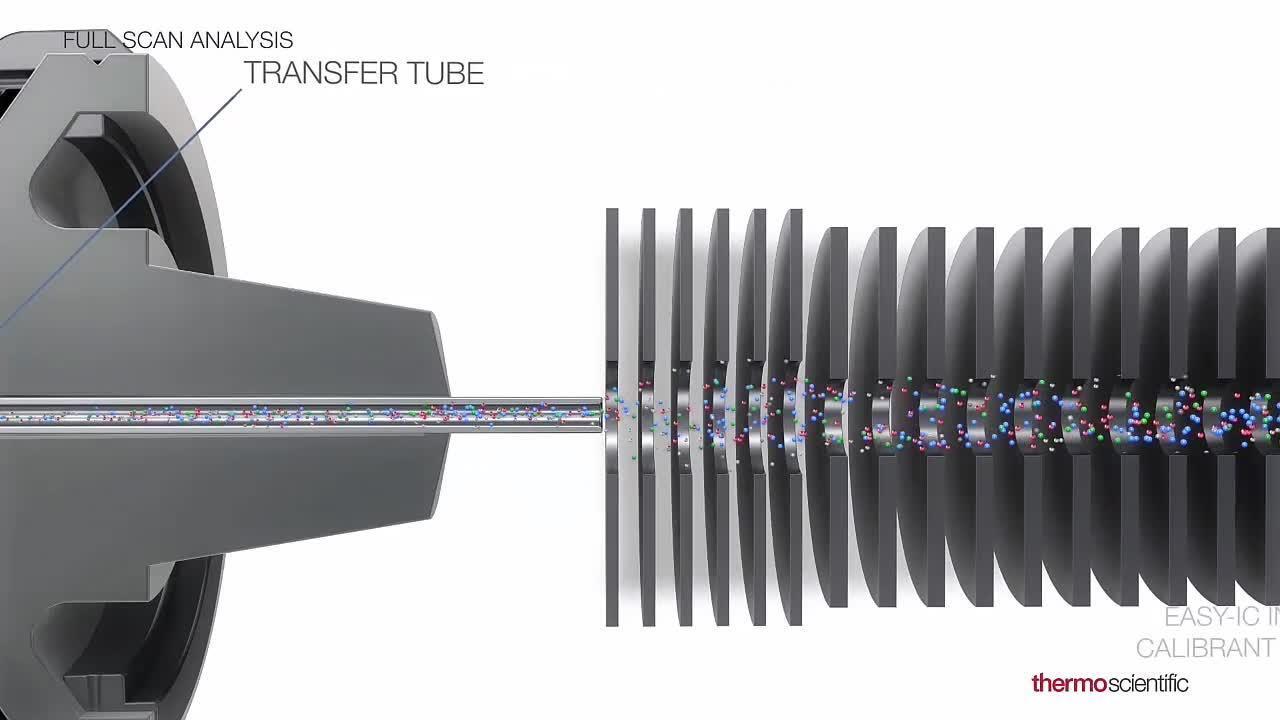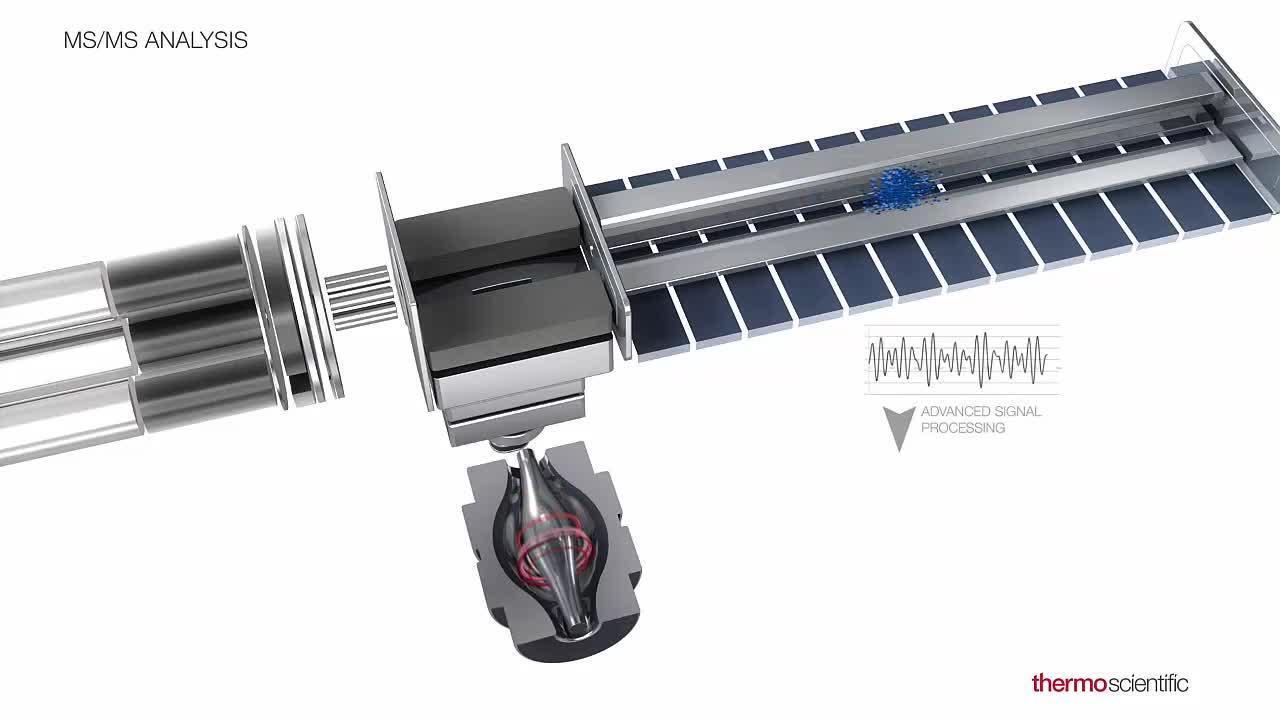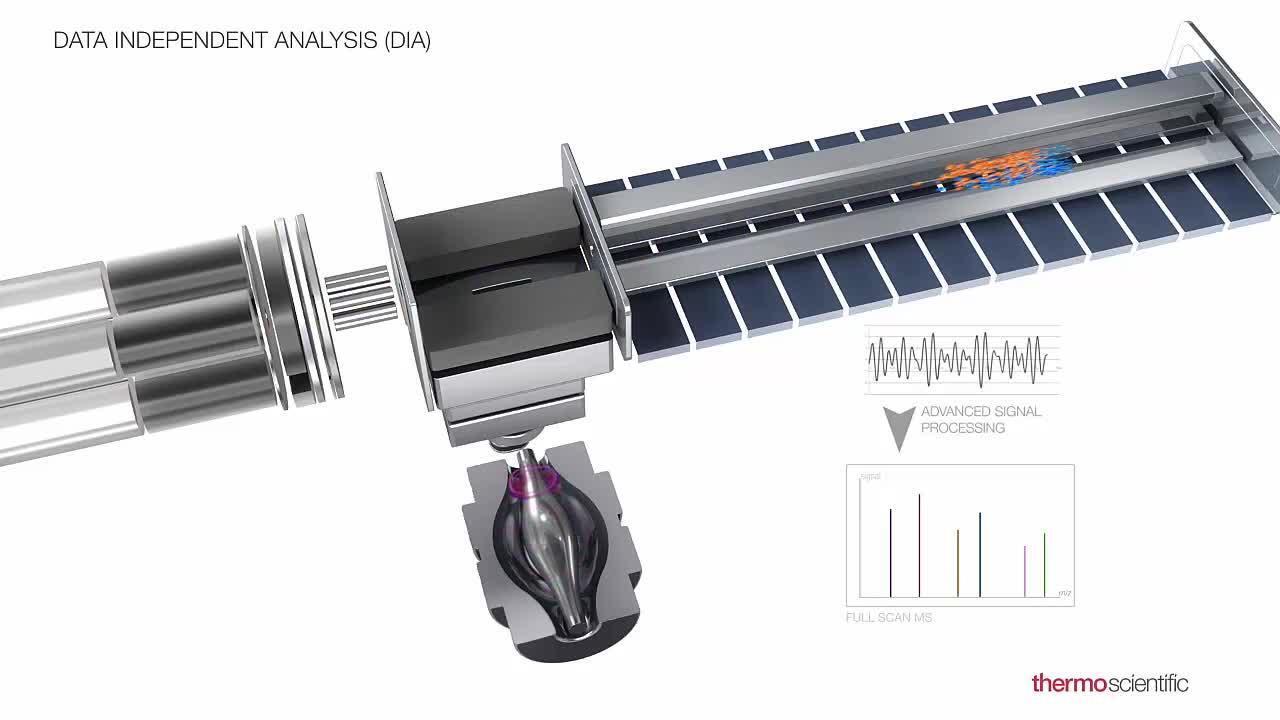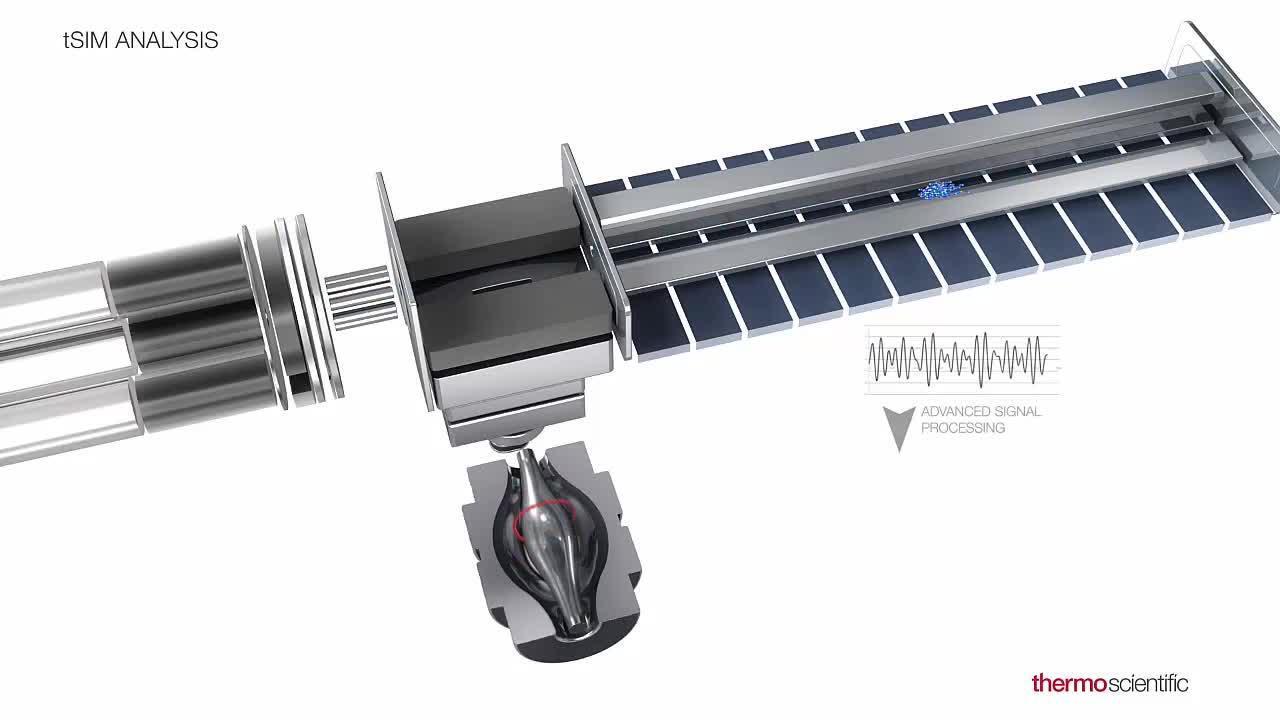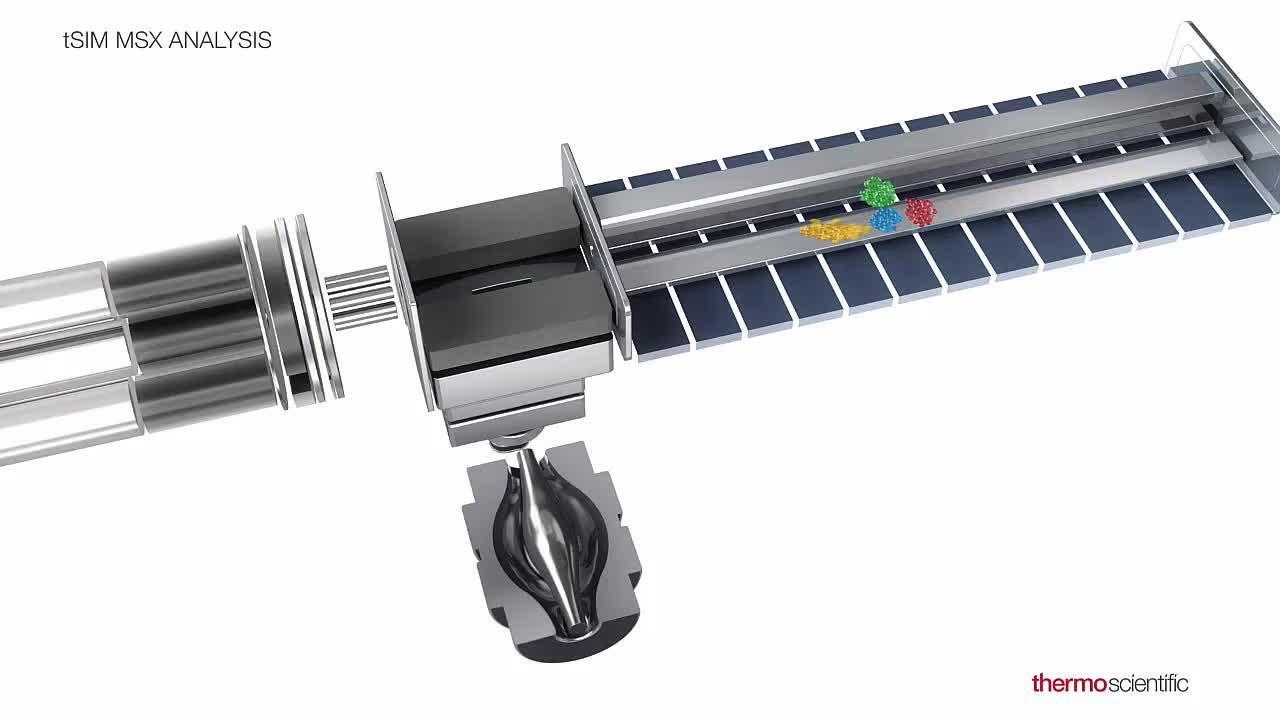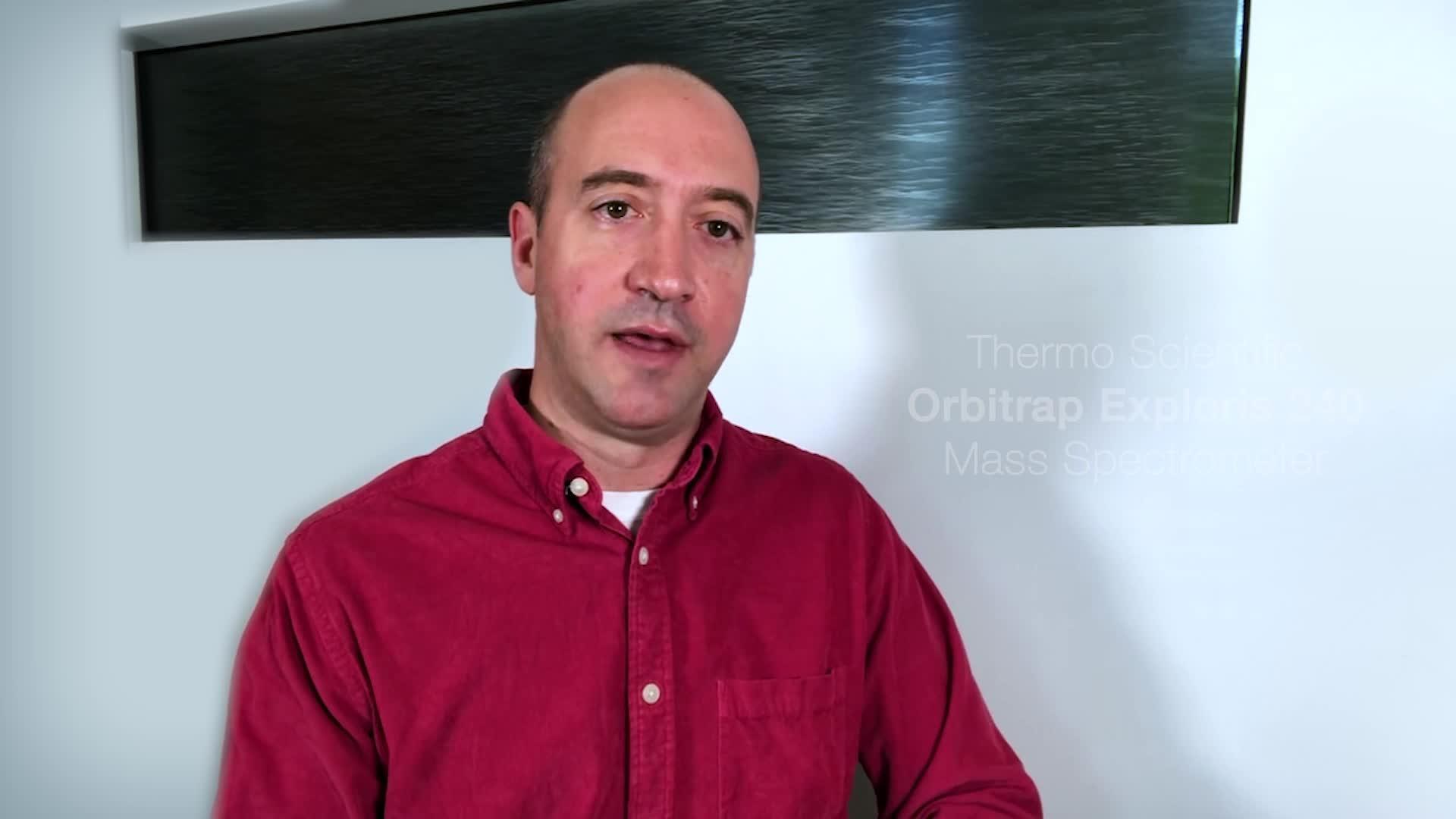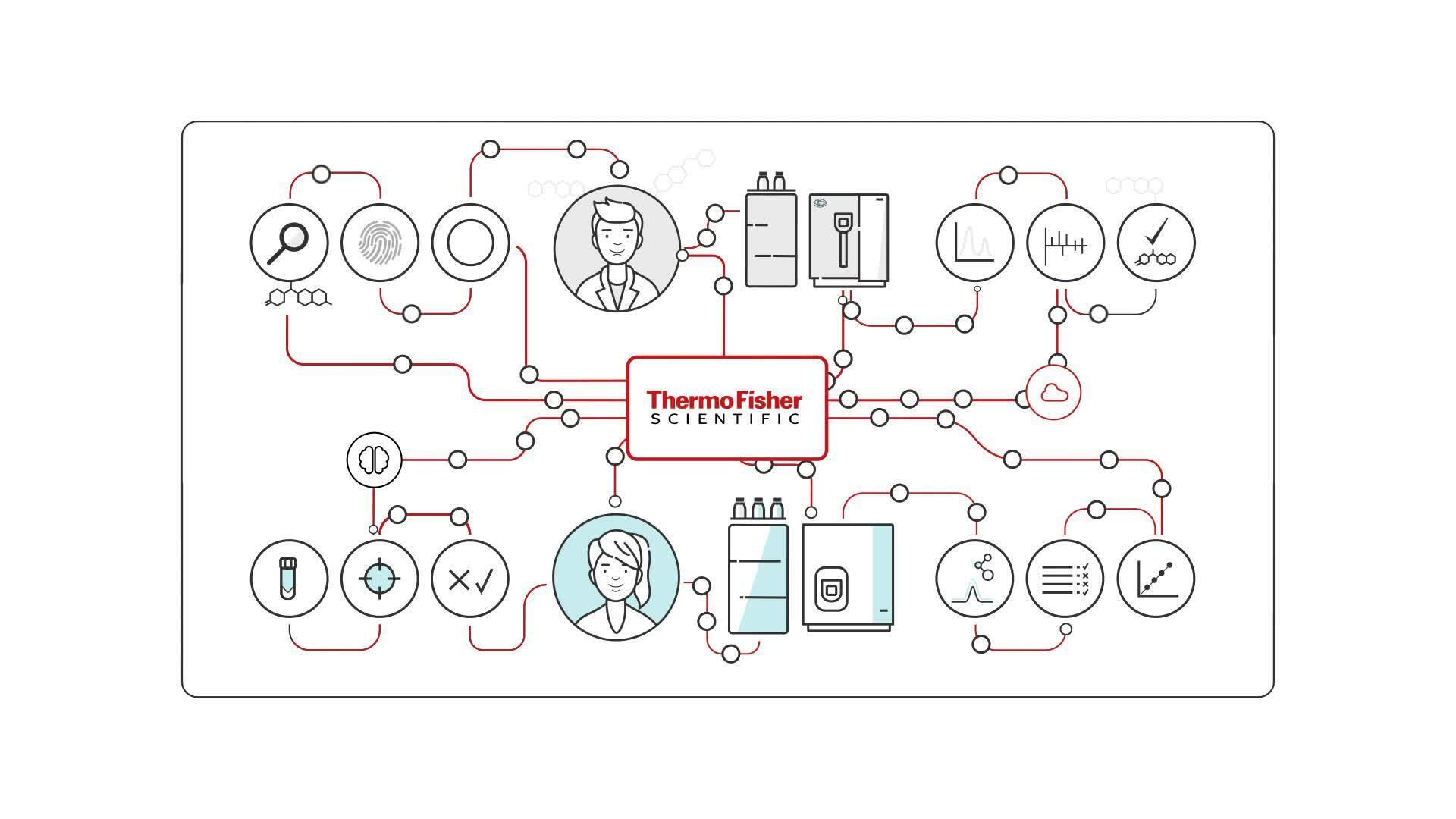Search Thermo Fisher Scientific
Orbitrap Exploris 240 Mass Spectrometers


Deliver the exceptional
Deliver on your objectives with the Thermo Scientific Orbitrap Exploris 240 mass spectrometer by combining application flexibility with the performance to drive discovery and identification, plus receive the quantitative precision and accuracy you need to confidently scale up and achieve impact. With operational simplicity through intelligent data acquisition and processing, discover your fast track to confident results regardless of sample complexity, the depth of insights required or the presence of unknown compounds.
On this page
Key benefits of the Orbitrap Exploris 240 mass spectrometer
| Everyday experimental flexibility | Faster path to confident insights | Reliable, robust, and maintainable | Focus on driving results with faster setup |
|---|---|---|---|
| Discover workhorse versatility from confident proteomic and small-molecule identification and quantitation to biopharmaceutical characterization and in-depth sample-profiling. | Delivering actionable insights faster than ever before by combining proven benefits of Thermo Scientific Orbitrap technology, such as sub 1-ppm mass accuracy and high resolution, with intelligent data acquisition and processing. | Meet an exceptional system every day, one with versatility and operational simplicity, but that doesn’t compromise robustness and reliability so you can be confident in its ability to perform on long-term studies. | Fully integrated instrument control, setup, and data processing, helps you focus on delivering actionable results while single-system calibrations and pre-defined method templates drive productivity. |
How does the Orbitrap Exploris 240 MS work?
Explore how the Orbitrap Exploris 240 MS enables experimental versatility without compromising data certainty. Built on the guiding principles of operational simplicity and reliability, the Orbitrap Exploris 240 MS combines more than 20 years of know-how with high-resolution capability and exceptional and consistent mass accuracy, empowering all users to fast-track their science.
We used feedback from customers and service engineers on the Thermo Scientific Orbitrap Exploris 480 mass spectrometer to design a new system from the ground up to deliver the improved reliability and the exceptional performance you expect from Orbitrap mass analyzer technology.
With source architecture shared across all next-generation mass spectrometers, accessing the improvements from the Thermo Scientific Orbitrap Tribrid platform enables increased sensitivity, robustness, minimal optimization and maintenance, and the ability to rapidly switch between sources.
The highly optimized design provides a compact physical footprint while still providing high performance across all application areas. This compact footprint was achieved using a single turbo-pump with six-stage pumping, with fewer moving parts, lower electricity consumption, less noise and weight.

Enhanced ruggedness with the Thermo Scientific OptaMax™ NG ion source, vent-free maintenance of the transfer capillary, efficient ion focusing with improved S-lens ion optics, noise reduction through axial field and injection filtering (AABG), variable precursor isolation width from 0.4 to 1,200 Da and MS/MS precursor ion selection with high transmission from m/z 40 to 2,500, all provide efficient transport of ions for detection or fragmentation.
Robust ion trapping for MS scans and higher energy collisional dissociation (HCD) MS/MS within the Ion-routing multipole (IRM) combines with reliable Automatic Gain Control (AGC) measurements for controlled injection of the number of ions into the fast-scanning, high-field Orbitrap mass analyzer for premium workhorse quantitative and qualitative performance.
Set-it and forget-it, with at least five days of maximum mass accuracy through the built-in Thermo Scientific EASY-IC™ (internal calibration) ion source. Both maintenance- and set up-free, EASY-IC technique ensures complete confidence with sub-ppm mass accuracy day after day, allowing smaller extraction windows or tolerances to be used for your quantitative and qualitative data analysis, streamlining data decisions – especially when combined with the exceptional resolving power of the Orbitrap Exploris 240 MS.

The analysis of 15 veterinary drugs spiked into meat muscle matrix using positive/negative polarity switching over 15 days following calibration, and using the EASY-IC ion source, demonstrates exceptional mass accuracy at sub 1-ppm, thus providing high confidence for subsequent identification, characterization, and quantitation analyses.
Mass accuracy on its own only allows you to get so far. Being able to access resolving power from (FWHM) 15,000 to 240,000 at m/z 200 with exceptional mass accuracy enables absolute confidence when performing elemental analysis to aid in compound characterization and identification, or when differentiating between isobaric glycoforms in complex protein samples.
High-resolving power provides the capability required to differentiate between matrix interferences and analytes of interest. Etoxazole (m/z 306.1770) and Isopyrazam (m/z 360.1883), within olive oil matrix, require a resolution of greater than 120k to baseline resolve these species and provide confident identification.
The analysis of biotin provides excellent mass accuracy, and at resolutions greater than 120k, access to isotopic pattern determination as shown for the A1 and A2 isotopic clusters, this reduces the number of potential elemental compositions and provides assurance in assignments.
Your samples contain vast amounts of information, which provides both knowledge and value. However, complex samples can limit the utility of data-dependent and independent analysis strategies due to collection of irrelevant data from background matrix, presenting the challenge of capturing “everything of interest.”
Using proven Thermo Scientific AcquireX intelligent data acquisition workflow, collect more meaningful data, increase profiling efficiency, and generate the highest quality MS2 data while reducing manual experimental set up and subsequent data interpretation.
To address the various needs of small-molecule research and unlock your data’s true value, there are four different AcquireX routines available; these automatically control which samples are analyzed, the order of acquisition, and the number of replicates acquired, depending upon the depth of compound coverage required.

Utilize maximum instrument duty cycle and avoid fragmenting background ions and unrelated sample peaks by automatically generating an ion exclusion list.

Focus on the sample-relevant chromatographic peaks by generating an ion inclusion list from a matrix sample to further reduce uninformative fragmentation spectra by prioritizing the molecular ion.

Obtain exhaustive fragmentation information for all small molecules, while avoiding fragmention of the same ion twice with automated exclusion list updates over multiple iterative injections.

Intelligent exclusion of background ions and comprehensive fragmentation of sample-relevant compounds across iterative injections achieve ultimate sample interrogation.

Using Data-Dependent Acquisition (DDA) with the AcquireX data acquisition workflow improves data quality and significantly increases the number of compounds with MS2 spectra, resulting in improved Thermo Scientific mzLogic algorithm ranking and higher Thermo Scientific mzCloud™ mass spectral library similarity scores when processed using Thermo Scientific Compound Discoverer software, ultimately providing higher overall confidence in compound identification and putative unknown identification.

Numerous emerging contaminants were confidently identified in pooled water samples using the Deep Scan AcquireX data acquisition workflow, with greater than 90% MS2 coverage being obtained within three injections. As MS2 data is acquired for all compounds, retrospective data analysis can easily be performed without the need to re-analyze the sample.
From full scan MS or targeted acquisition modes for small-molecule quantitative analysis, label-free or Tandem Mass Tag (TMT) multiplexing quantitation for proteomic and translational studies, through to biotherapeutic analyses, the Orbitrap Exploris 240 MS mass accuracy and resolving power ensures consistent and reliable sensitivity and quantitative accuracy.

The size exclusion chromatographic (SEC) MS analysis of trastuzumab from 50 to 0.2 µg on-column load is shown (left), demonstrating the utility of intact native analysis (center) with the Thermo Scientific BioPharma option to extend the mass range to m/z 8000 in generating reduced complexity spectral data when compared to denaturing conditions. With consistent glycoform distributions (right) even at low sample loads, the simplicity of operation makes routine native MS analysis a possibility.
Setting up your instrument to acquire high-quality data shouldn’t be a bottleneck. Instrument calibration across the entire mass range from m/z 40-6,000 (including the BioPharma option) involves a single calibration in both positive and negative modes using Thermo Scientific Pierce FlexMix calibration solution.
The method editor is consistent across our next-generation instrumentation, as well as Thermo Scientific Xcalibur and Thermo Scientific Chromeleon Chromatography Data System (CDS) software. With ready-to-use, application-specific templates, the intuitive method editor uses a drag-and-drop method to edit, or create your own methods, allowing you to focus on achieving your experimental objectives with minimal set-up, regardless of MS system experience.

The common method editor combines both instrument control and data acquisition parameters. The use of extensive templates for the most common experiments allows you to acquire high-quality data from the start, or use drag and drop to rapidly create and visualize your own experiments.
In addition to the extensive capabilities of AcquireX workflows for automated and in-depth small-molecule characterization, there are a range of data acquisition modes which provide versatile experimental capabilities to assist you in seeing more, quantifying more, and delivering access to the knowledge and value contained within your samples.
Full scan MS: Acquisition of MS data without any fragmentation across a given mass range, where the quadrupole in front of the Orbitrap mass analyzer is operated as a wide-pass mass filter.
MS/MS (ddMS2): A precursor ion is selected for fragmentation within the Ion-Routing Multipole (IRM); the quadrupole is set to transmit only the m/z of the precursor ion which passes into the IRM where higher-energy collisional dissociation occurs (HCD).
DIA (Data-Independent Acquisition): Following a full scan MS, the quadrupole isolates a narrow mass range which is then advanced to the IRM where “all ion fragmentation” is performed before being detected. For each subsequent scan, the quadrupole shifts the isolation mass range upwards until the desired mass range has been analyzed.
tSIM (Targeted Selected Ion Monitoring): Similar to full scan MS followed by MS/MS, tSIM operates the quadrupole using a narrow mass range (survey scan) to limit the number of ions entering the IRM before detection. tSIM is normally used to trigger product ion spectra (ddMS2); this mode is useful for lower analyte concentrations to improve product ion spectra.
Optional features to maximize performance
Maximize system performance and flexibility to expand experimental capabilities of the Orbitrap Exploris 240 mass spectrometer with hardware and software options, allowing you to see more, quantify more, and deliver more confidence and greater insights with even more productivity.
Achieve the ultimate sensitivity to increase LC-MS performance when you incorporate the easy-to-use Thermo Scientific FAIMS Pro Duo interface, a field asymmetrical ion mobility spectrometry (FAIMS) technique that seamlessly integrates with Thermo Scientific next-generation mass spectrometers. Together they deliver superior selectivity for analytes of interest, enabling greater qualitative and quantitative performance while reducing time-consuming sample preparation steps.
Learn more about how the FAIMS Pro Duo interface enhances experimental performance
The ever-increasing molecular complexity of biotherapeutics demands innovative analytical techniques which facilitate confident and complete characterization. With the option to extend the mass range up to m/z 8000, the Orbitrap Exploris 240 mass spectrometer BioPharma option enables characterization of intact proteins under both native or denaturing conditions, in addition to top- and middle-down through to peptide mapping studies.

An example of utilizing the extended mass capabilities of the BioPharma option to enable the size-exclusion (SEC) and pH gradient elution cation exchange chromatography (CEX) analysis of trastuzumab under native MS conditions, showing on-column loadings and the resulting spectra with reduced spectral complexity. Over a wide dynamic range, the sensitivity provides low levels of detection which enables the use of native MS for sample-restricted studies, while maintaining in-depth levels of confident characterization of protein microheterogeneity.
Others claim to set new standards in proteomics. Is Protein ID without quantitation sufficient for shotgun proteomics to provide biological insights? Meet the Orbitrap Exploris 240 mass spectrometer – with leading quantitative performance, sensitivity and versatility, designed to meet your needs.
Trust us to deliver technology innovations that are foundations of reliable workflows and solutions, along with publishable and actionable results.
Application capabilities through instrument versatility
Maximize performance and flexibility to expand your experimental capabilities, allowing you to discover more, see more, quantify more, and deliver more confidence and greater insights with even more productivity.
From core laboratories looking for industry-regarded proven mass resolution, accuracy, speed, and intelligent data acquisition approaches to expand capacity, or provide extra versatility, the Orbitrap Exploris 240 mass spectrometer is the premium high-resolution, accurate-mass (HRAM) workhorse to accelerate your discoveries and enable trusted biological insights.
Take your discoveries beyond just identification, and link complex biological function with trusted, best-in-class relative and targeted quantitation to see the bigger picture. Protein identification without quantitation is only part of the picture.

For identification and shotgun proteomics, the optional FAIMS Pro interface leads the way in increasing the breadth, depth, and sensitivity of your studies.
Quantitative proteomics strategies using Tandem Mass Tags enable precise measurement of protein abundance from multiple samples into a single, high-resolution LC-MS analysis. Increasingly, various biological experiments demand higher multiplexing and sample throughput with accurate quantitation.
a) Quantitative experimental design for the analysis of a control and three knockout (KO) strains. b) The orthogonality of the FAIMS Pro interface shows improved peptide coverage when using a range of different CVs. c) Intensity ranking across five orders of quantitative dynamic range for the peptide spectrum matches provided by Proteome Discoverer software. d) Quantitative ratios for each of the samples, highlighting the relative abundance of the KO proteins.
Translational research solutions demand scalable, standardized, and reproducible workflows. The Orbitrap Exploris 240 MS is the premium workhorse MS/MS system designed to deliver the highest confidence in quantitative proteome profiling for large-scale plasma and tissue sample cohorts, supporting precision medicine and translational projects.

Through integrating automated sample preparation, sample clean-up and separations, and built-in QA/QC procedures with the Orbitrap Exploris 240 MS and the leading data processing capabilities of Thermo Scientific Proteome Discoverer software, we provide a complete solution, delivering rigorous, relevant results that accelerate the translation of discoveries into clinical applications now and into the future.

a) The uHTPPP automated sample preparation workflow provides a high-throughput workfow delivering significant time savings, from ×4–12 fewer hours depending upon the workflow step.
b) Demonstrating consistent and precise plasma protein characterization over 150 injections (130 samples and 20 QCs), the box plots show the averaged number of proteins identified with the total proteins identified and quantified highlighted. For the 200 ng sample load across six days using a 24 minute analysis, the CV was less than 5% showing workflow reliability.
Providing greater insights into denatured and native intact MS analysis, sub-unit top- and middle-down analysis through to peptide mapping, the Orbitrap Exploris 240 MS delivers high-confidence biotherapeutic characterization with unmatched spectral clarity.
Assign more spectral features with the application flexibility, speed, dependability, and operational simplicity required across research and routine environments for reliable quantitation and identification performance using the powerful data processing capabilities of Thermo Scientific BioPharma Finder software.
Ion exchange chromatography can be performed using volatile buffers with low salt concentrations to provide compatibility with MS, enabling detailed characterization of low abundant modifications that may be more difficult to obtain with size exclusion chromatography (SEC). To explore the sensitivity and dynamic range of the Orbitrap Exploris 240 MS, SEC and pH gradient elution cation exchange chromatography (CEX) were employed for the analysis of the class 1 monoclonal antibody (mAb) trastuzumab.
- SEC-MS analysis. Base peak chromatograms of sample load from 50 ng to 50 µg of trastuzumab
- SEC-MS charge envelopes detected between m/z 5,000 and 7,000 (3 scans, acquired with 10 µscans each, were averaged)
- Normalized intensities plotted to estimate LOD & LOQ
- Zoom into the MS spectra showing +26 charge state of the SEC-MS analysis for the different sample amounts of mAb analyzed, showing exceptional spectral reproducibility independent of loading
Exceptional sensitivity and mass accuracy with the proven spectral quality of Orbitrap MS for native intact proteins, even at low levels, provides confident and reproducible deconvoluted intact masses.

Under denaturing conditions, the complex glycoform distribution of infliximab is clearly observed. Mass stability for the deconvoluted glycoforms over 18 days shows exceptional precision, which with the high resolving power, enables confident identification performance.
Sub-unit and middle-down analysis, or bottom-up analysis of complex biotherapeutics is easily performed using the high-resolution, accurate mass capabilities and HCD fragmentation capabilities of the Orbitrap Exploris 240 MS. Monoisotopic masses for subunit analysis, or sequence coverage for peptide mapping analyses, are easily performed and visualized within BioPharma Finder software.
Identify trace process modifications easily
a) Chromatogram showing ipilimumab subunit separation with the leading edge highlighted. b) The leading edge contained low levels of endogenous mono- and doubly-oxidized glycoforms of the Fc/2 G0F subunit. c) The deconvolution result using the Xtract algorithm within BioPharma Finder software represents unoxidized, mono- and doubly-oxidized G0F glycoforms.
Ipilimuamab sub-unit bottom up analysis
Mass accuracy and sensitivity combine with rapid and complete digestion using Thermo Scientific SMART DIGEST kits to ensure 100% sequence coverage for peptide mapping analyses. The powerful and highly visual data processing capabilities of BioPharma Finder software quickly highlights complete sequence coverage, as well as the confidence in assignments.
Obtain valuable quantitative insights from untargeted, semi-targeted and targeted metabolomics experiments, relative to absolute quantitation, in a single system. With innovations that deliver built-in AcquireX intelligent data acquisition strategies to collect more meaningful data, the Orbitrap Exploris 240 MS redefines versatility – from small- to large-scale studies through flexible curated workflows and powerful data processing capabilities with Compound Discoverer software ensuring fast time to results, day after day.

Together with single-click calibration and established method templates, the Orbitrap Exploris 240 MS delivers unsurpassed qualitative and quantitative Orbitrap mass analyzer data quality across a comprehensive range of metabolomics workflows.
Mild trapping settings minimize artifacts
Avoid misannotated metabolites with mild trapping to reduce unintentional MS1 precursor ion dissociation. The m/z 116.0706 product ion of ornithine shown in the MS1 spectra above, could be mistaken as proline which shares the same exact mass. Compared to standard trapping, the level of fragmentation is lower using mild trapping, as seen with the red chromatographic trace.
Extended low mass for small molecules
With an extended low mass range down to m/z 40, the confident identification of isomers and small molecules is improved with the detection of more fragment ions. An extended low m/z range enables confident identification of isomers. In the case of 2-aminobutyric acid (top) and dimethylglycine (bottom), there are five additional fragment ions detected allowing confident differentiation between these two structural isomers.
Leverage the high resolution, accuracy, and sensitivity of Orbitrap mass analyzer technology to address critical challenges faced in quantitation of proteins in complex biological matrices and accelerate your clinical research, translating your qualitative and quantitative assays into future clinical applications.
The complexity of plasma samples presents a challenge when quantitating proteins and identifying real changes, especially for low abundance proteins.
The analysis of beta actin, a low abundance protein found in white blood cells and platelets, for low centrifuge force (a-c) and high centrifuge force (d-f), shows depletion (x40 lower relative concentration) within plasma which was properly spun out; demonstrating the accuracy, sensitivity and resolving power of Orbitrap technology in addressing these analytical challenges.
Regardless of your small-molecule application, ensuring long-term robustness of qualitative and quantitative data is critical for confident decision making. Fast-track to your results through absolute confidence in data, delivering reproducible productivity.
Excellent scan-to-scan mass accuracy and stability enables more confident assignments to be obtained, even at low intensities, for unknown compound analyses. As shown above for atrazine (m/z 216.1010), each datapoint is within ±0.5 ppm regardless of peak intensity, which combined with high resolving power provides the basis for robust data analysis.
This degree of mass accuracy across a broad dynamic range is obtained without the need to average data, and also allows for narrow extraction windows to be used when quantifying, increasing specificity and accuracy.
The ability to utilize consistent sub-ppm mass accuracy for precursor confirmation while screening provides high levels of confidence. However, while with the fast scanning capabilities of the Orbitrap Exploris 240 MS and the use of high-quality mass spectral fragmentation libraries, such as mzVault, provides additional levels of data confidence.
Above shows data from the DIA analysis of pesticides within olive oil. At a concentration of 1ppb, we see excellent spectral fragmentation matching between the library and experimental data for etofenprox.
Data Analysis with connectivity to drive productivity
From complex proteomic challenges, complete biotherapeutic characterization, or small-molecule discovery to everyday testing, data analysis is your gateway to accessing deeper insights into your high-quality MS and MS2 data. Despite the numerous workflows involved, there are flexible analysis tools for simple, confident interpretation of your data to streamline research and facilitate rapid decision making.
Comprehensive protein identification, characterization, and quantitation with Proteome Discoverer software
Proteomics research requires more than just simple identification. Proteome Discoverer software offers a full suite of analysis tools with the flexibility to address multiple research workflows, and an easy-to-use, wizard-driven interface. Confidently interpret your data with sophisticated statistical and visualization tools unique to Proteome Discoverer software and utilize third-party algorithms to take your analysis to the next level.
Rapid delivery of confident biotherapeutic characterization data outcomes
Complete protein characterization can be challenging, whether you are performing intact protein mass analysis, top- and middle-down analysis, peptide mapping or multi-attribute method (MAM) workflows. Access workflows that facilitate comprehensive interpretation and data visualization, allowing you to confidently characterize your biologics with speed and ease. From novel deconvolution algorithms generating complete results to easy-to-understand data visualization tools, BioPharma Finder software helps you choose the right path for confident protein characterization with direct export to Chromeleon CDS software for compliant quantitative intact mass deconvolution and targeted peptide mapping.
Connecting small-molecule unknown identification and characterization through to screening and quantitation doesn’t just stop at data acquisition across multiple platforms; now that you have acquired comprehensive, high-quality MS and MS2 data, you need to identify and characterize unknowns and transfer discovery knowledge through to everyday testing.

Our connected data processing software ecosystem streamlines interpretation of your high-confidence discovery data, through powerful Compound Discoverer software with direct access to the world’s largest LC-MSn reference spectral library, mzCloud, or through utilization of offline or proprietary libraries. These libraries act as your knowledge repository and allow direct transfer through to everyday screening and quantitation using Thermo Scientific TraceFinder software.
Confident decisions can only be made when using extensive, high-quality spectral libraries. With exhaustive and chemically diverse high-resolution MSn fragmentation spectra, know more unknowns using mzCloud, the world’s largest LC-MSn reference spectral library, delivering powerful characterization and identification capabilities.

For offline mzCloud mass spectral library access, or the ability to curate your own proprietary libraries, Thermo Scientific mzVault allows you to store and share knowledge across our qualitative and quantitative application packages to drive confident decision making.
Go from spectra to structure and data to knowledge
Transform small-molecule data, whether a small or large dataset, from full-scan and MS2 data into known compounds and molecular pathways. Compound Discoverer software offers a full suite of advanced software tools for known-compound and unknown-compound identification. It streamlines compound identification, determines real differences between samples and elucidates biological pathways with integrated, powerful software workflows to drive rapid insights from your valuable data.
No matter what your small-molecule research application, from metabolomics to biomarker discovery, environmental and food safety, pharma metabolite or impurity identification, extractables and leachables to forensic or clinical toxicology, Compound Discoverer software offers a unique approach to small molecule structural identification software.
Simplifying high-throughput screening and quantitation
Driven by a powerful and intuitive acquisition and data processing tools, TraceFinder software provides rapid access to your results and increases output across the entire laboratory, with direct target input from Compound Discoverer software and access to mzVault offline mass spectral database for additional confirmation through MS2 spectral matching for screening.
Smart sample flagging, flexible data review, and custom report generation remove bottlenecks associated with data review and simplify sample analysis at each step of the process.

Chromeleon Chromatography Data System (CDS) is the first CDS that combines separation (GC/IC/LC) and mass spectrometry (MS) in an enterprise (client/server) environment. With comprehensive MS-specific data views, data processing, and reporting capabilities, merging the benefits of Chromeleon CDS software with our leading MS instrumentation and application expertise provides a superior answer to productivity challenges within the analytical laboratory.
For compliant bioanalysis, targeted analysis and quantitation of intact proteins or peptides with a direct import from BioPharma Finder software, through to screening and quantitation, Chromeleon CDS software brings productivity and compliance to high-resolution mass spectrometry.
Simplify your instrument management. Review and share instrument history, stay updated on current acquisition status, and prepare for what’s next—all from one accessible productivity tool. Thermo Scientific Almanac Application maintains an instrument logbook and recent utilization statistics for your connected mass spectrometer. Real-time acquisition status can be assessed anytime and anywhere by visiting the secure Almanac webpage or mobile app, or by configuring real-time alerts that will get delivered through either email or the mobile app. Finally, if you have a problem on any of your configured instruments, request technical support with a single click through the Almanac Agent.
Ordering guide
Related products
Orbitrap Exploris GC 240 mass spectrometer
For compound identification and quantitation, the Orbitrap Exploris GC 240 mass spectrometer delivers high- quality, information-rich data and results.
Featured videos on Orbitrap HRAM technology
Explore a New Dimension in Proteomics Quantitation
Thermo Scientific Velocity LFQ DIA Platform
The quantitative accuracy and precision you need from the leader in unbiased label-free DIA quantitation – and with new value pricing that more easily delivers the impressive performance you’ve asked for.
Successful Grant-Writing Starts Here
7 steps to your grant-writing success
A well-thought-out and detailed grant proposal is essential. Our technical experts are with you every step of the way in the grant-writing process to help you reach new heights.
LC-MS webinar series
Expand your application knowledge
Our LC-MS on-demand webinar series expands your application knowledge for pharma, biopharma, environmental, omics, food, forensics and clinical research and more. Learn how the latest high-performance mass spectrometry solutions can enable your laboratory to solve your most pressing analytical challenges, regardless of sample type.
Watch this video to learn how to maximize your return on investment in a unified Thermo Scientific mass spectrometry architecture from data acquisition through analysis solutions.
mRNA Solution Guide
Discover innovative analytical solutions to meet the wide range of analytical needs for mRNA vaccines and therapeutics. Achieve confident characterization of the extensive list of critical quality attributes (CQAs) to meet regulatory requirements.
Grant Application Resource
The grant application resource will help you accelerate high-confidence insights for small- and large-molecule research using the Orbitrap Exploris 240 mass spectrometer.



